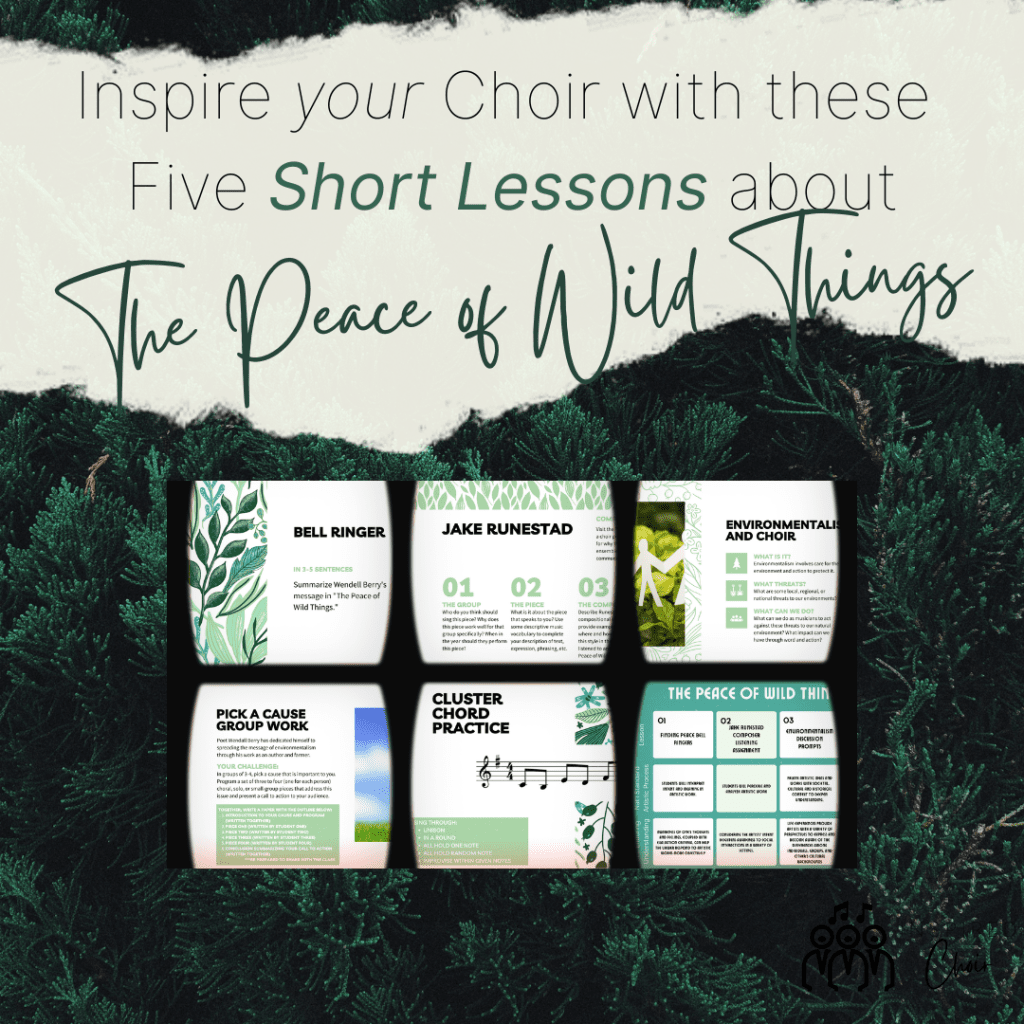Explore The Peace of Wild Things by Jake Runestad
Inspired Choir reader Brianne Partington requested a post on The Peace of Wild Things by Jake Runestad, and I was more than happy to oblige. This week’s post marks our second Reader Request feature! (The first was about Modimo – check it here) Do you have a piece you’d like me to feature? Let me know in the comments below!
This gorgeous piece by Runestad not only challenges singers with clustered harmonies and rising musical gestures throughout, but also asks them to consider humanity’s relationship with the Earth. In this post, I examine the following aspects of Runestad’s The Peace of Wild Things:
- Get to Know Composer Jake Runestad
- The Activist Behind the Poem: Wendell Berry
- Finding Our Peace in the Wild
- Choral Connections to Environmentalism
- The Peace of Wild Things Teacher Resources
Take a listen and peruse the score on the composer’s website – linked here.

Some of the links below are affiliate links. This means that, at zero additional cost to you, I will earn an affiliate commission if you click through the link and finalize a purchase.
“I Come Into The Peace”
I asked Inspired Choir Reader Brianne Partington why she loves The Peace of Wild Things. She responded: “I’ve sung my fair share of Jake Runestad pieces during my college years (and met him too!). What I love about The Peace of Wild Things and American Triptych as a whole is the connection they make between nature and humanity.”
She continued: “In this geopolitical and high-stress world, we could all relate to the first 3 lines of Wendell Berry’s poem that are sung, quite symbolically, by the basses (as an alto, I feel a bit of pride for my male counterparts getting the spotlight). However, what we could take from this is how nature serves as a way to cope with our complex thoughts and feelings. It’s all in the title line: ‘I come into the peace of wild things who do not tax their lives with forethought of grief.'”
“I hope, in spirit in the blog’s name, this song inspires readers to find peace in the simple things when the world and our minds get a little noisy.”
Beautifully said, Brianne. Thank you for your suggestion and contribution! Below, I dive into the composer and poet behind the work, propose discussions that this piece evokes, and share a bit about environmentalism and it’s connection to choral music.
The Peace of Wild Things Composer Feature: Jake Runestad
Lauded as a “choral rockstar” and “one of the best of the younger American composers,” Jake Runestad has established himself as a compositional mainstay in the choral arena. With a 2020 Grammy nomination and recent Emmy Award Win in 2022 and countless commissions and compositional awards, Runestad’s musical vision certainly resonates with choral musicians.
Runestad is known for his sensitivity when text-setting and approach to difficult issues in our time. In The Peace of Wild Things, Jake Runestad marries the text of a poet and environmental activist to an “earthly palette throughout” in the piano accompaniment, “underscoring the scene at the edge of a mountain lake.”
In an interview with Explore Classical Music, Runestad shared that the appreciation of nature was central to his upbringing, as he comes from an outdoorsy family. He finds inspiration from nature often and shares this inspiration “in hopes of helping us to protect this beautiful earth that we call home.”
A few other must-listen Jake Runestad pieces:
- Just premiered in the summer of 2022, I Was Love features for SATB choir, solo voice, piano, percussion, and electric bass and text by Fenton Johnson that explores the universal connections we have with other living beings. Take a look at the commission story here.
- After my students heard another choir perform Nyon Nyon at a choral festival, they demanded that we program it that year. I obliged and was delighted by their enthusiasm for this piece.
- With five short movements, Fireflies allows SATB ensembles the opportunity to explore a variety of voicings, timbres, and musical character through Rabindranth Tagore’s mini-poems.

Poet Feature: Wendell Berry
Author Wendell Berry has penned more than eighty books of poetry, fiction, and essays. He is well-known for his environmentalism, support for small farms, and distrust of technology. Not afraid to speak up about his beliefs, Berry blames the global economy for the break-down of traditional values and local economies.
In addition to writing a prolific amount of work, Berry farms full-time, working his land with horses and utilizing natural fertilization. Although he spent time traveling and living in New York City and abroad in Europe as a young man, Berry prefers to live an agricultural lifestyle to this day, completing most of his writing in a camp house with no electricity.
The poet’s care for the environment comes through in nearly all of his work, including within The Peace of Wild Things. Originally published in 1968, this poem has not lost any of its impact over time. Listen to the poet read The Peace of Wild Things here.
Finding Our Peace in the Wild
To summarize the The Peace of Wild Things text, the speaker expresses that when they feel despair for the world, they go rest in nature and find peace and freedom. In an era when technology reigns, we often need to escape to natural places where we can find peace.
One of my go-to moves for singing more expressively is to visualize myself within the poetry of the piece. In the case of this song, it is easy to place myself resting and recharging in one of my many nature “happy-places.” I often find that when I am emotionally connected to the music’s message, my delivery becomes much more clear.
SEL-INSPIRED CONVERSATIONS
When diving into emotionally-driven discussions with singers, I like to frame our conversations with the Social Emotional Learning Competencies. (I talked a bit about SEL here.) Below are a few discussion starters for The Peace of Wild Things:
| SEL Competency: | Discussion Prompts: |
|---|---|
| Self-Awareness | What might cause you to feel despair for the world? What sort of emotions do you link to this feeling of despair? Do any social circumstances enhance these feelings of despair? |
| Self-Management | When you feel despair for the world, to what natural places might you escape? How might you combat these feelings of despair? Does nature serve as a place of rest and recharge for you as it does for the speaker in The Peace of Wild Things? |
| Decision Making | As you sing The Peace of Wild Things, what musical decisions can you make to share with your audience the emotions associated with first the despair for the world, then rest in the grace of the world? |
| Social Awareness | Are you aware of anyone in your choir (or in your life in general) who might be feeling despair for the world? What signs might they display to indicate that they are struggling with the state of the world? Why might they not be seeking rest and recharge? |
| Relationship Skills | How might you support a friend or colleague who is feeling despair due to current events or environmental threats? What actions or conversations might you have to validate their feelings and encourage them to find rest? |
If you want to know more about Social Emotional Learning, I encourage you to check out the books linked below. These are some of my favorites!

Environmentalism and Choir
Environmentalism involves concern about the environment as well as action taken to protect its longevity. Although ecological awareness has been documented for at least 5,000 years, the dawn of environmental rights did not occur until the 18th century. The global movement of ecology did not begin until much later in the mid-1950’s.
Recently, many choirs have been embracing environmental messages. Earth day, nature, and environmental themes are popular with many ensembles, especially in the spring.
Some ensembles have even embraced environmentalism as an essential point in their mission. For example, We Are the Voice Children’s Choir calls themselves a Children’s Environmental Choir. They aim to act as environmental ambassadors by singing for “the climate, trees, oceans, wildlife facing extinction and for the children’s future.” They endeavor to raise spirits and inspire community action through their work.
Want to add environmentalism to your choir’s vision? The Choirs for Climate page provides a few suggestions for becoming an eco-friendly choir. For example, consider including encouraging car-sharing and public transport use. Maybe use a projector for words at community sings rather than physical copies. They suggest you employ digital devices for music when possible, utilize an online program for concerts, and encourage the use of reusable water bottles. Additionally, Choirs for Climate suggest you publicize any changes so your audiences may see you practice what you preach.
Complementary Pieces
Want to listen to other pieces like The Peace of Wild Things? Or planning a concert and need some programming ideas? Here are a few complementary pieces!
Enjoying the Nature Appreciation vibes?
- Rachel Portman’s Earth Song for SATB with lyrics from poet Nick Drake and activist Greta Thunberg expresses the Earth’s voice, asking us to listen.
- The River by Susan Labarr celebrates the stability and sense of home we find in nature.
- On a recent Choir Fam Podcast, Alysia Lee mentioned that she is working with Artemisia on an environmental justice commission. I will be keeping my ears open for this!
Thinking about a Songs of Peace theme?
- Combine your treble and mixed ensembles for Jim Papoulis’s There Is Peace for SATB with 2-part Treble Choir Descant. I love Papoulis’s work for developing ensembles, especially because he typically uses student words to create his lyrics, which makes it so relatable for students.
- Allan Naplan’s Sim Shalom is a beautiful and hopeful two-part call for peace.
- Connect to the 1970s Peace and Environmental Justice movements with Cat Stevens’s Peace Train arranged by Kirby Shaw.
Other Reader Request Repertoire Features:
- Modimo by Michael Barrett
- More to come in 2023!
I’d Love to Hear from You!
Have you sung or conducted The Peace of Wild Things with your choir? How did you approach the environmentalism themes with your ensemble? Where do you find peace in the wild? What other Jake Runestad pieces do you love? Let me know in the comments below!

The Peace of Wild Things Teacher Resources!
FREE The Peace of Wild Things Reading Comprehension Worksheet
Reading Comprehension Worksheets pull five key points from the blog post above. Additionally, they ask singers to consider musical decisions they can make with the info from this post. Fill in the form below and get a link to a folder including all 2022 Reader Request Post Worksheets immediately!
The Peace of Wild Things by Jake Runestad Lesson Plan Bundle
Check out the Inspired Choir Shop for the The Peace of Wild Things Lesson Plan Bundle. This bundle includes the following five minute lesson plans, all with connections to National Standards and SEL Competencies:
- Finding Peace Bell Ringers
- Jake Runestad Composer Listening Assignment
- Environmentalism Discussion Prompts
- Pick A Cause Group Project
- Cluster Chord Practice Activity





















